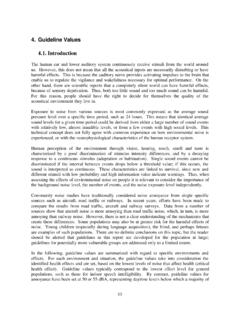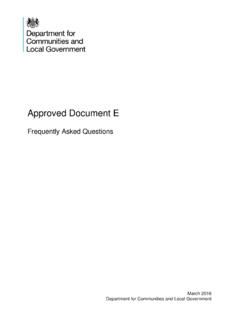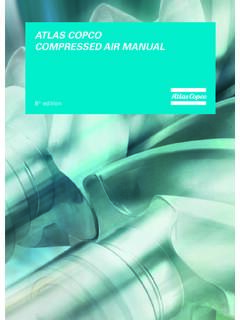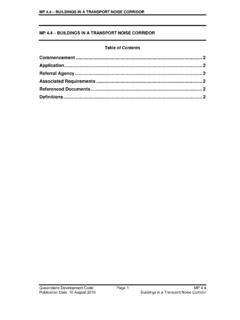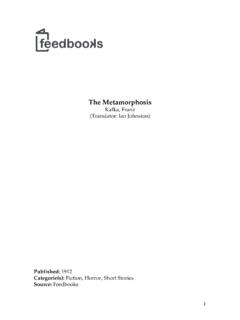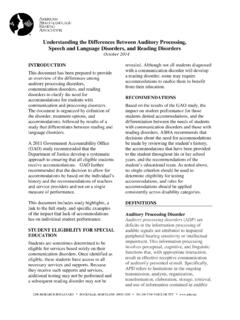Transcription of Acoustic design of schools: performance standards
1 Acoustic design of schools: performance standards Building bulletin 93 February 2015 2 Version control Version Amendments Author/reviewer Approved by Date V14 Published Richard Daniels Technical Manager, EFA Ann Bodkin Head of design and Specification EFA 18 December 2014 V15 Minor typos Richard Daniels Ann Bodkin 22 December 2014 V16 Minor correction in table 1 for performance / recital room Richard Daniels Ann Bodkin 28 January 2015 V17 Table references in figures 1,2 and 3 corrected to 4a and 4b Richard Daniels Ann Bodkin 3 February 2015 3 Contents Version control 2 Contents 3 Summary 6 About this publication 6 Acknowledgements 6 Disclaimer 6 Expiry/review date 6 Who is this advice for?
2 6 Key points 6 Definitions 7 School client body 7 0. Introduction and scope 8 Background 8 Regulatory framework 8 Building Regulations 8 School Premises Regulations and Independent School standards 9 Equality Act 2010 9 Areas covered by the regulations 9 Teaching and non-teaching spaces 9 Temporary buildings 10 New-build, conversion and refurbishment work 10 Material changes of use 10 Nursery and community education 11 Sixth-form colleges, universities and colleges of further education 11 When do the regulations apply? 12 Planning issues 13 performance in use 13 Provision for children having special hearing or communication needs 13 Special school accommodation and special units attached to mainstream schools 14 4 Alternative performance standards 15 Surface spread of flame rating of Acoustic linings and absorbers 15 Durability and robustness 16 Acoustics and ventilation 16 1.
3 performance standards 17 Indoor ambient noise levels in unoccupied spaces 18 Objectives and definitions 18 Acoustic performance standards 18 Building services and indoor ambient noise levels 21 Noise from ventilator actuators and dampers 25 Airborne sound insulation between spaces 26 Objectives and definitions 26 Acoustic performance standards 26 Exceptions 27 Airborne sound insulation between circulation spaces and other spaces used by students 27 Objectives and definitions 27 Acoustic performance standards 28 Impact sound insulation of floors 30 Objectives and definitions 30 Acoustic performance standards 30 Exceptions 32 reverberation in teaching and study spaces 32 Objectives and definitions 32 Acoustic performance standards 33 reverberation and Acoustic absorption in sports halls and swimming pools 35 Objectives and definitions 35 Acoustic performance standards 35 Demonstrating compliance 35 Sound absorption in corridors and stairwells 36 Objectives and definitions 36 Open plan teaching and learning 36 5 Objectives and definitions 37 Acoustic performance standards 37
4 Exceptions 38 Demonstrating compliance 38 2. Compliance 39 Procedures 39 Alternative performance standards 39 Acoustic commissioning 39 References 40 Further information 42 Useful resources and external organisations 42 Other relevant departmental advice and statutory guidance 42 Other departmental resources 42 6 Summary About this publication This document supersedes section 1 of Building Bulletin 93 (BB93) published in 2003. It sets out minimum performance standards for the acoustics of school buildings, and describes the normal means of demonstrating compliance with the Building Regulations.
5 It also provides guidance in support of the School Premises Regulations (2012) and the Independent School standards (2013). Acknowledgements The Department for Education (DfE) would like to thank the Schools Committee of the Association of Noise Consultants and the Institute of Acoustics for their help in drafting this document. Disclaimer DfE and its advisers accept no liability whatsoever for any expense, liability, loss, claim or proceedings arising from reliance placed upon this document. Expiry/review date This advice will next be reviewed in 2019. Who is this advice for?
6 This advice is for all those involved in the specification, design and construction of school buildings. Key points The overall objective of the performance standards is to ensure that the design and construction of school buildings provide Acoustic conditions that enable effective teaching and learning. 7 Definitions School client body The school client body consists of both the commissioning authority and the school entity. The school entity has day to day control of the school and may be represented by the headteacher or a governor. The commissioning authority is the authority that commissions the work: central government, a local authority or the school itself.
7 8 0. Introduction and scope Background This document should be read in conjunction with Acoustics of schools: a design guide , published by the Association of Noise Consultants and the Institute of Acoustics, which contains supporting information and additional design considerations. References to the guide are made throughout this document. On publication, the guide will supersede sections 2 to 7 of Building Bulletin 93 (2003) Section 1 of this document sets out the Acoustic performance standards . The normal way of satisfying Requirement E4 of the Building Regulations , the School Premises Regulations and the Independent School standards is to meet the appropriate performance standards in section 1.
8 Section 2 of this document sets out the preferred means for demonstrating compliance of the design to Education Funding Agency (EFA) or other school client body. The school design will need to take into account other environmental needs of the pupils such as thermal comfort, indoor air quality, infection control, ample surfaces for display materials and easy access to outside areas. Regulatory framework The Acoustic conditions in schools are controlled by Part E of the Building Regulations, School Premises Regulations and the Independent School standards , which apply to new and existing schools.
9 School premises are also subject to the Equality Act Building Regulations Requirement E4 from Part E of Schedule 1 to the Building Regulations 2010 (as amended by Statutory Instrument, SI 2002/2871) states: Each room or other space in a school building shall be designed and constructed in such a way that it has the Acoustic conditions and the insulation against disturbance by noise appropriate to its intended use. Approved Document E in support of the Building Regulations gives the following guidance: In the Secretary of State s view the normal way of satisfying Requirement E4 will be to meet the values for sound insulation, reverberation time and internal ambient noise which are given in section 1 of Building Bulletin 93 The Acoustic design of Schools , produced by DfES.
10 Note: Department for Education and Skills (DfES) is now DfE). 9 School Premises Regulations and Independent School standards The School Premises Regulations and Independent School standards applies to both new and existing school buildings and contain a similar statement to that in Requirement E4 of the Building Regulations: The Acoustic conditions and sound insulation of each room or other space must be suitable, having regard to the nature of the activities which normally take place therein. In addition to the design and construction standards covered by the Building Regulations, the School Premises Regulations and Independent School standards cover the performance in use of schools including speech intelligibility in the classrooms.











